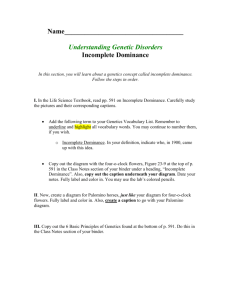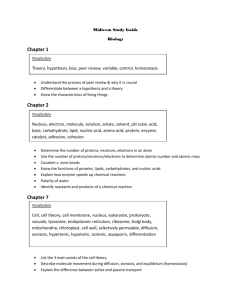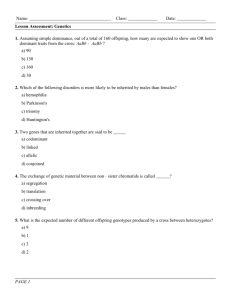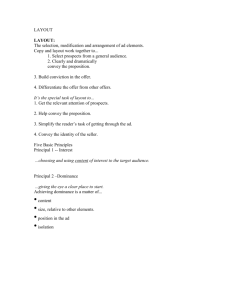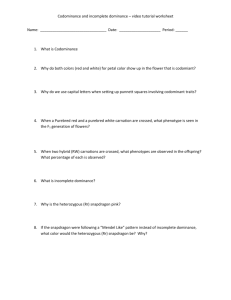Dominance and Its Evolution
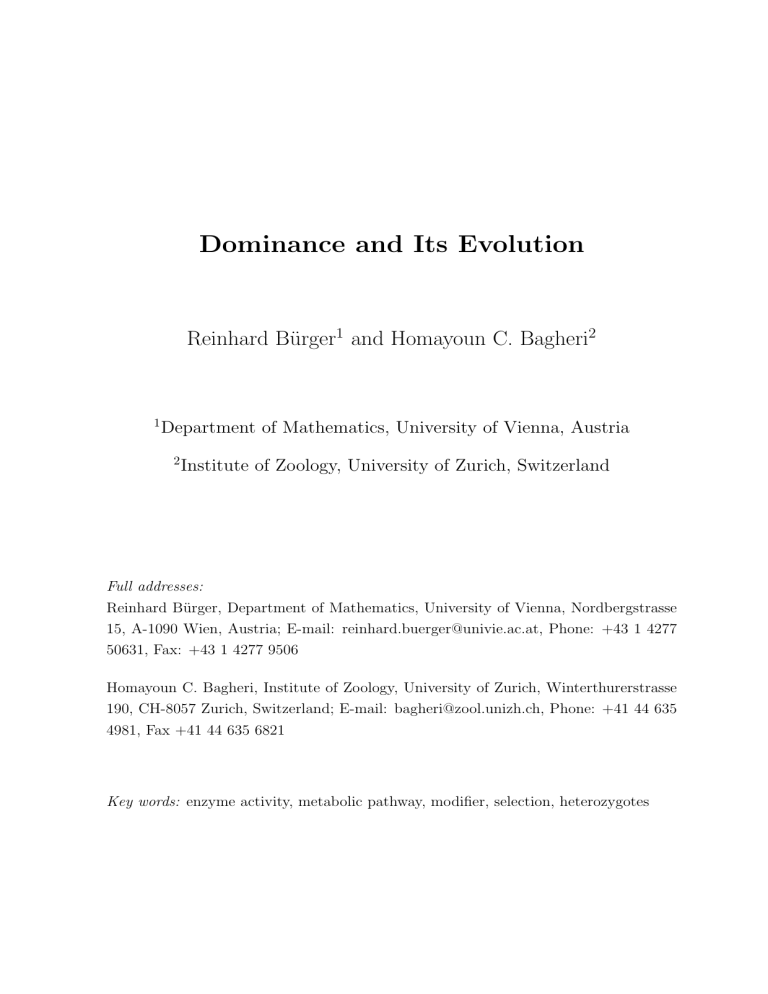
Dominance and Its Evolution
Reinhard B¨urger
1
and Homayoun C. Bagheri
2
1
Department of Mathematics, University of Vienna, Austria
2
Institute of Zoology, University of Zurich, Switzerland
Full addresses:
Reinhard B¨urger, Department of Mathematics, University of Vienna, Nordbergstrasse
15, A-1090 Wien, Austria; E-mail: reinhard.buerger@univie.ac.at, Phone: +43 1 4277
50631, Fax: +43 1 4277 9506
Homayoun C. Bagheri, Institute of Zoology, University of Zurich, Winterthurerstrasse
190, CH-8057 Zurich, Switzerland; E-mail: bagheri@zool.unizh.ch, Phone: +41 44 635
4981, Fax +41 44 635 6821
Key words: enzyme activity, metabolic pathway, modifier, selection, heterozygotes
Synopsis
Dominance is a ubiquitous phenomenon of great evolutionary importance. We review empirical facts about the degree of dominance, present theories explaining its molecular basis, outline empirical facts and theories on the evolutionary modification of dominance, and discuss the controversies revolving around this topic. We conclude that molecular pathways can often generate dominance due to inherent physiological constraints, and that the latter do not necessarily require evolutionary explanations based on selection. Nonetheless, molecular pathways can allow for dominance modification, and hence, dominance evolution. Furthermore, evolution of dominance has been demonstrated in many well-studied ecological settings, and whether due to selection or otherwise, their evolutionary origin needs to be addressed.
Introduction
As Gregor Mendel noted in his seminal paper of 1865, it had been known for some time that hybrids are usually not exactly intermediate between the parental species. Mendel introduced the term dominant to refer to characters that are transmitted almost unchanged to the hybrids, and recessive to those that become latent. In the meantime, more than a century of genetics has shown that dominance is a ubiquitous phenomenon with most deleterious mutations being recessive. Dominance is not only ubiquitous, but clearly of great evolutionary importance because it masks the effects of deleterious mutations as long as they are rare and occur predominantly in heterozygous individuals. Mutations are rarely completely dominant or recessive, but usually intermediate, also called codominant. Complete absence of dominance is uncommon, however. The degree of dominance plays an important role in the explanation of several evolutionary phenomena. These include the evolution of sexual reproduction and recombination, the evolution of selfing, Haldane’s rule on inviable species hybrids, and the maintenance of genetic variation of metric traits. It is also well established now that dominance is a property of the phenotype and not the gene because genes that affect several traits can be dominant for one trait and recessive for an other.
1
In 1928, R.A. Fisher raised the question why most deleterious mutations are recessive and proposed a model for the evolutionary modification of dominance relations.
This was motivated by early experiments by W. Bateson and others which had demonstrated that dominance relations can be modified by changing the genetic background or, later, by selection. Fisher’s theory was criticized by Sewall Wright for reasons discussed below. As an alternative, he suggested that the explanation of dominance has a strong physiological component. In agreement with Wright, J.B.S. Haldane held that dominance provides a factor of safety, in that a single dose of the most active allele would, suitably regulated, provide enough of the gene product for normal viability.
Fisher’s hypothesis led to fierce controversies between proponents of ‘physiological’ and
‘evolutionary’ explanations. In 1981, Kacser and Burns developed a molecular explanation using metabolic control theory which, by many, was taken as evidence that an evolutionary explanation of dominance is obsolete. Still, there are many demonstrated cases of evolution of dominance in natural systems. In the meantime, alternative molecular theories, also based on biochemical principles have been proposed. Despite its central importance and a huge body of empirical and theoretical work, no generally valid explanation for dominance has been provided until today. In fact, disagreement among scientists about several issues related to its explanation abound.
We shall start with a brief summary of empirical and experimental facts. Then we shall highlight and evaluate the various explanations of dominance (molecular basis of dominance), the theories that have been proposed for the evolution of dominance, as well as some the main controversies. Finally, we will suggest a possible reconciliation.
Empirical facts
It has been known for long, and is a generally accepted fact now, that mutations with major (deleterious) fitness effects are almost always recessive. In the simplest case of two alleles, A and a , at a locus, the fitness of the three possible genotypes, AA , Aa , and aa , are usually denoted by 1, 1 − hs , 1 − s . Here, s is the selection coefficient and h the dominance coefficient. A mutant is neutral if s = 0 and lethal if s = 1. If h = 0, then
A is dominant and a is recessive; if h = 1, then a is dominant and A recessive; if h = 1
2
, one says there is no dominance; if 0 < h < 1, one speaks of intermediate dominance or codominance; if h < 0, then there is overdominance, whereas underdominance prevails
2
if h > 1.
Estimates of dominance
Measuring the coefficient of dominance, h , in particular, for mutations of small effect
( s ), which constitute the vast majority of all mutations, is difficult. Direct estimates can be obtained from spontaneous mutations in mutation-accumulation experiments of highly inbred lines. Such assays are very laborious. By assuming mutation-selection balance, indirect estimates can be obtained from the structure of segregating populations. These estimates, however, are based on additional assumptions that often cannot be checked and also face statistical challenges. Therefore, they are not very reliable, and the development of methods for measuring dominance coefficients is an active field of research.
All known data demonstrate widespread correlations between dominance and fitness effects of mutations, i.e., mutations with a large deleterious effect tend to be more recessive than those with a small effect. This is true for coding genes and, more recently, has also been shown for non-coding genes. Because fitness and dominance effects vary across loci, and the locus at which a mutation occurs can often not be determined, in general, only average coefficients of dominance (¯ s ) can be inferred.
Available data suggest that ¯ is on the order of 0.1 – 0.2 and decays approximately exponentially with increasing s .
Mutations not only affect fitness, or fitness components, but phenotypic traits. In fact, the fitness effect is a consequence of a mutation’s effect on one or several traits. If these are closely correlated with fitness, then the fitness effect may be large. Many traits, however, for instance morphological traits, influence fitness only weakly. Dominance effects have been estimated with respect to traits that can be measured on a metric scale. For such metric traits (e.g., body size, oil content in maize, or abdominal bristle number in Drosophila , the latter being extremely well studied genetically), average dominance coefficients appear to be close to 0.5 and depend only weakly on the size of the mutational effect. In particular, no significant skew has been observed.
Compared with intermediate dominance, over- and underdominance are rare. The probably best-known example for overdominance is sickle-cell anemia, which provides immunity against malaria in heterozygous state. Over- and underdominance often seem to be the consequence of frequency-dependent selection or spatially heterogeneous se-
3
lection. The first occurs if the heterozygotes have an overall advantage, for instance because they are generalists and can use most or all available resources. Underdominance can easily occur by migration-selection balance if each of the two homozygotes is optimally adapted to a different ecological niche and heterozygotes are maladapted because they don’t have their own niche.
Modification of dominance
Numerous experiments have shown that dominance relations can be changed experimentally by substitution of the genetic background or by selection. Therefore, certain genes have the ability to modify the character expression, and such genes seem to be abundant.
Most empirical evidence for evolutionary modification of dominance concerns wing patterns in lepidopteran species, mimicry in butterflies, and pesticide resistance. A classical example is provided by industrial melanism in the peppered moth Biston betularia , a lepidopteran species. During the second half of the 19th century, dark forms of this usually light-colored insect became more common in industrial areas and within about fifty years nearly replaced the light form. One of the reasons why the melanic form gained a selective advantage was that the tree trunks on which these butterflies rested became blackened due to pollution which killed light lichen, and the light form, originally cryptically colored, became better visible to their predators. Interestingly, the dark from became dominant during this process. Extensive experiments by H.B.D.
Kettlewell in the 1950s and 1960s suggest that selection for an unlinked modifier occurred during the spread of the favorable mutant. Later, similar experiments were performed in related species with slightly different outcomes, which may be explainable by linked modifiers that, initially, had a different frequency as in B. bitularia. Since the ecological setting is complex, other selective forces as well as migration-selection balance may also have played an important role. In all of these cases it seems that an, originally, recessive or intermediate allele became more or less dominant.
A quite different situation was observed in some cases of mimicry by P.M. Shepard,
C.A. Clarke, and others in the 1950s and 1960s. There, frequency-dependent selection maintains overdominance, and one of the homozygous phenotypes is modified to resemble the heteroyzgotes.
Another well-studied class of examples for dominance evolution concerns insecticide
4
resistance genes. Often the genes causing resistance, and sometimes even those causing dominance, are known. Since pesticide applications are heterogeneous in space, and alleles conferring an advantage in treated areas tend to be disadvantages in untreated areas, underdominance is often maintained by migration-selection balance.
Explanations of dominance and its evolution
Basic scenarios for the evolution of dominance
Almost all population-genetic explanations for the evolution of dominance are based on scenarios involving selection. Distilled down to its simplest form, the common idea in these models is the notion that given a set of homozygous and heterozygous genotypic variants, one or more of the less fit variants evolve to resemble the fitter variant at the phenotypic level. Consider a starting condition in which the phenotypes associated with a pair of allele variants are codominant. The original scenario proposed by Fisher, was one in which the fitness landscape associated with the three alternate genotypes mimics the qualitative shape of the phenotypic landscape. Hence one of the homozygous variants is fitter than its alternate, and the heterozygote is intermediate in fitness.
Figure 1A depicts such a scenario. In the latter case, dominance could evolve if the phenotype of the heterozygote is modified (via selection) to resemble the fitter homozygote. This would lead to dominance of the fitter phenotype, and a form of robustness with respect to mutations, since now the effects of the less desirable allele are masked in the heterozygotes.
The noteworthy concept here is that when considering a phenotypic landscape that is described as function of the genotype at a single-locus, the landscape is not necessarily fixed. Consequently, fitness in relation to a single-locus genotype is also not necessarily fixed. In this scheme, the question that remains is what are the causes by which the relation between genotype and phenotype can change. One possibility is a change in the environment. A second is a change in the genetic background. The latter case is usually the main protagonist in models of dominance evolution. In the simplest case, changes in the genetic background can be represented as changes in alleles at a
“modifier locus”, which in turn modify dominance relations with respect to alleles at a “primary locus”. All such modifier models and their more complicated derivatives inherently assume that the relation between genes at separate loci and the phenotype
5
are non-additive (i.e., non-independent) and that the latter relation can be modified by gene interactions. Non-additivity, whereby allele substitutions at one locus can alter the phenotypic effects of substitutions at another locus, is referred to as “epistasis”. Models of dominance evolution via changes in the genetic background inherently assume the existence of epistasis.
If mutational effects at one locus can be modified by substitutions at another, then the general scheme presented in Figure 1A is not the only scenario by which dominance could evolve. Two commonly considered scenarios are presented in Figures 1B and C.
Both rely on balanced polymorphisms as the starting condition. One possible scenario is when the heterozygote is superior in fitness to the homozygotes (Fig. 1B). Dominance would evolve under such a condition if the phenotype of one of the homozygotes is modified to resemble the fitter heterozygote. The reverse starting condition can be also considered, whereupon either homozygote is superior to the heterozygote (Fig. 1C).
In the latter case, dominance would evolve if the heterozygote is modified to resemble either one of the homozygotes. The latter starting condition is more complicated from the population genetic perspective, since the maintenance of a balanced polymorphism involving two fit genotypes depends on frequency-dependent selection.
The situations presented in Figure 1 deal with the possibility of dominance modification due to selection —provided that a physiological trait of interest can be modified, and that it can be subject to selection. In the next section, we consider some of the physiological grounds for the manifestation of dominance modification. Whether population conditions allow for selection to be an effective force, is itself a decisive matter.
This will be discussed in a subsequent section.
Mechanistic explanations for dominance: the case of metabolism
During the beginning of the Twentieth Century, one of the more prominent explanations for dominance, attributed to Bateson and C.R. Plunkett, was the “presence-andabsence” hypothesis. Consider a situation in which a phenotype or trait comes about as a result of the action of a set of gene products. One can conceive of a situation in which each gene i plays a role X i for the formation of a given phenotype P . The presence-absence hypothesis assumes that as long as there is one functional copy of gene i, then the role X i is satisfied, and hence, P remains at wild type levels. With advances in physiological genetics, and subsequent advances in molecular biology, the
6
Figure 1: Idealized representation of some situations under which dominance could evolve
7
presence-absence hypothesis has been abandoned. Nonetheless, we should note that the prime weakness in the presence-absence hypothesis was not necessarily its incomplete representation of the underlying mechanisms; all mechanistic representations of genotype-phenotype relations are at some level incomplete. By the standards of today, the presence-absence hypothesis is more a logical argument than a detailed exposition on mechanism. However, its major failure was that as a phenomenological description, it failed to fit much of the mounting experimental evidence; it was not general enough to explain many exceptions.
Given present knowledge of the variety of molecular processes occurring in the cell, such as gene regulation, signal transduction and metabolism, it would now seem unreasonable to use any specific mechanistic model as a general model for dominance modification. Depending on the underlying causes of a given phenotypic trait, the proximal causes for dominance modification and the constraints placed upon it can be very different from one case to the next. Hence, any given molecular explanation may serve as an instantiation of general concepts pertaining to dominance modification, but it is unlikely to serve as the grand model for modification. Nonetheless, if any given modification model is sufficiently well-developed, it can be used to test some general evolutionary questions.
The case study that has been most central to addressing dominance evolution revolves around phenotypes that are directly dependent on the functioning of metabolic enzymes. Shortly after the introduction of Fisher’s model, both Wright and Haldane argued that the proximal causes for the manifestation of dominance would have to depend on the underlying physiology. At the time, enzymes and their biochemistry were at the forefront of mechanistic explanations for the inner workings of organisms.
Accordingly, they also had a central role in Wright and Haldane’s explanations. With the assumption that most genes code for enzymes, and the use of a simplified nonlinear model of enzyme pathways, Wright tried to address dominance from a physiological perspective. Based on his model, he hypothesized that the rate of substrate formation throughout a pathway will have a diminishing returns relation to enzyme concentrations (Fig. 2A). Under such circumstances, when enzyme concentrations are in the flat region of the curve, then reductions in enzyme concentration will have relatively small effects on substrate levels. Accordingly, let us assume that a wild type homozygote AA has two copies of a gene coding for an enzyme E , while the mutant heterozygote Aa
8
has one functional copy. Furthermore, let us assume that enzyme concentrations are proportional to copy numbers, and hence that the concentration of functional enzyme
E , and consequently enzyme activity, is halved in Aa genotypes in comparison to AA .
If the AA genotype lies deep in the plateau region of the curve in Figure 2A, then the reduction of enzyme concentrations in Aa genotypes to half of AA would not have an appreciable effect on phenotype, and the wild type phenotype associated with AA would be considered dominant. In Wright’s model, dominance of the wildtype results from the convex shape of the relation between enzyme activity and phenotype. As a counter example, a concave curve such as the one in Figure 2B would lead to the wild type being recessive. In the context of Figure 2A, dominance of the wild type would evolve when wild type enzyme activity is pushed to the flat end of the curve. Conversely, as exemplified by the a 0 a 0 homozygote in Figure 2A, a phenotype that is associated with the steeper part of the curve will tend toward co-dominance with respect to the null aa homozygote.
The physiological model discussed above ignores compensatory effects such as gene regulation, feedback, redundancy, and non-sequential pathway topologies. Nonetheless, as a model, it is a plausible case study for addressing questions related to dominance and its evolutionary origins; in fact, it has been central to research on this topic. An important question that arises within this model, is the reason whereby wild type enzyme activities should be in the high end of the curve. Haldane’s suggestion was that organisms could evolve a “factor of safety” against perturbations. Such perturbations could in principle be either environmental or genetic. Another explanation could be that high enzyme activities are simply required for individual fitness, and due to the convex shape of the curve, dominance evolves as a side effect of selection for high enzyme activity.
As an alternative explanation for dominance, Kacser and Burns suggested that in metabolic systems, one could explain dominance without making recourse to evolutionary explanations. Their argument is based on models that are at first sight similar to
Wright’s model. However, there is a fundamental difference. In Wright’s model, levels of dominance can be modified by changing the enzyme activity associated with the
“wild type” homozygote. The Kacser and Burns’s model (from here on abbreviated as the KB model) places a crucial constraint on this modification. In the latter case, dominance can be modified at any given locus in the same sense as in Wright’s model.
9
Figure 2: Physiological model for dominance based on enzyme activity and substrate accumulation
10
However, the KB model also suggests that modifications that result in increased phenotypic sensitivity to any enzyme, are compensated by decreased sensitivity to other enzymes. Furthermore, the model also implies that the more enzymes are involved in a pathway, the smaller the average effect of each enzyme on the phenotype. Based on these premises, Kacser and Burns concluded that dominance — which depends on insensitivity of the phenotype to enzyme concentration changes — is a de facto property of metabolic pathways and that evolutionary explanations are not necessary.
Much of the mechanistic details of Wright’s model do not reflect what is known of enzyme kinetics today. However, his model does preserve some of the nonlinear aspects of chemical transformations. On the other hand, the KB model is more akin to modern conceptions of enzyme kinetics. However, the model contains some approximations that eliminate important nonlinearities in enzyme kinetics — namely, enzyme saturation.
The consequence is that the scope of the KB model is much more limited than originally intended and, in hindsight, not a good candidate for investigating the evolutionary origin of dominance. For example, Bagheri and Wagner have suggested that if one considers simple models of enzyme kinetics, with the possibility of enzyme saturation, one finds that system robustness or dominance is not a de facto property of enzyme systems. In particular, the compensatory constraints on dominance modification that are postulated in the KB model are eliminated when the system allows for saturation.
In fact, the modulation of enzyme saturation levels allows for dominance modification, and hence, dominance evolution. Figure 3 shows an example of a ten enzyme pathway, which contrary to the KB model, is modeled with the possibility of enzyme saturation.
The pathway consists of a constant input S
0 and an output substrate S
10
, whose rate of production (flux, dS
10
/dt ) is the phenotype of interest (Fig. 3A). As indicated by Figure
3B, each enzyme-catalyzed reaction can be conceptualized as a process by which a substrate and an enzyme join to form an enzyme-substrate complex, which subsequently dissociates into a product and the unaltered enzyme. Saturation levels can be altered by mutations that either change concentration levels or the dissociation constant k cat
.
Flux for such a model can be obtained by numerical integration of the resulting system of differential equations. Figure 3C shows the flux function for two realizations of a ten-enzyme pathway. The green lines trace a pathway whose enzymes possess relatively high k cat values. The black lines trace a pathway with low k cat values. Within each case, flux responses to changes in enzymes 2 to 10 are very similar, and the corresponding
11
curves are almost indistinguishable. Responses to enzyme 1 are slightly more sensitive.
What is important to note in this figure, is that we are observing two different endpoints of possible evolutionary trajectories. In the low k cat case, the wild type phenotype is co-dominant with respect to mutations that halve the concentration of any enzyme. In contrast, in the high k cat case, the wild type phenotype is dominant with respect to mutations that halve the concentration of any enzyme. Hence, one can conceptualize dominance evolution as an evolutionary process whereby k cat levels have been gradually modified from low to high values. High k cat values result in low enzyme saturation levels, and consequently, higher dominance levels for the wild type.
A further consequence of the model in Figure 3C is the important observation that there is a slight difference between the wild type AA phenotypes of the high and low k cat pathways. This means that if one is selecting for the high flux phenotype, one could select modifiers due to their direct fitness effects rather than their dominance modification effects. Direct effects can be relatively small, but they are not dependent on the frequency of a alleles. Meanwhile, modifying effects can be larger, but nonetheless they occur less frequently due to their dependence on the frequency of a alleles. Hence, selection for modifiers with multiple effects would circumvent some of the frequency sensitivity problems associated with modifier evolution. A schematic drawing of such a scenario is shown in Figure 4, which corresponds to the enzyme kinetic model in
Figure 3. Dominance evolution in such a scenario is more likely to be successful than in cases where modifiers only have a dominance modification effect (e.g. Figure 1A).
Interestingly, despite the lack of an explicit enzyme kinetic representation, the mathematical properties of Wright’s model are similar to the enzyme kinetic model presented here; namely, Wright’s model allows for the possibility of dominance evolution through multiple effects, while the KB model does not.
Evolutionary explanations for dominance
As discussed above, dominance relations are not necessarily fixed but can be modified and may even evolve. Fisher’s basic argument was the following: At mutation-selection balance, deleterious alleles are kept at low frequency in a population but, nevertheless, reduce its mean fitness. Therefore, genes that protect the population from the effects of recurrent deleterious mutations should be selectively favored and increase in frequency.
Since most rare alleles occur in heterozygotes, modification of the heterozygous pheno-
12
Figure 3: Model of dominance modification for the flux phenotype of a ten-enzyme pathway
13
Figure 4: Example of dominance evolution due to a modifier with multiple effects type would increase mean fitness. Wright introduced a model that formalized Fisher’s proposition and has become the archetypical model for the evolutionary modification of dominance. It assumes a primary locus at which a wild type allele, A , and a deleterious mutant allele, a , occur. In addition, it assumes a so called modifier locus, with alleles
M and m , where M modifies the fitness effects of heterozygous genotypes as follows:
AA Aa aa
MM 1 1 1 − s
Mm 1 1 − ks 1 − s mm 1 1 − hs 1 − s .
(1)
Here, the intensity of selection against a is s > 0, and the dominance coefficients satisfy
0 ≤ k ≤ h ≤ 1 and h = 0. Mutation is assumed to occur from allele A to allele a at rate u , and recombination between the two loci occurs with frequency r , 0 ≤ r ≤ 1
2
.
Fisher, and in order to refute him, also Wright, assumed that evolution commences at mutation-selection balance between A and a when at the modifier locus a new allele
M is introduced at low frequency. At this initial state, with fitnesses given by the last line of (1), the mean fitness of the population is approximately 1 − 2 u . If M became fixed, which wasn’t proved by Fisher or Wright but only much later, the first line in
(1) applies, and the mean fitness were increased to about 1 − u . This model is in line with the graphical representation in Figure 1A. Several more elaborate analysis in the 1960s and 1970s corroborated and extended Wright’s analysis. Given that per-
14
locus mutation rates are very small, typically on the order of 10 − 6 to 10 − 5 , this is a very small fitness increase. Whereas Fisher considered this as sufficient, Wright argued for the contrary because, in his opinion, genetic drift could easily overcome this tiny fitness advantage and likely cause the loss of the modifier. In addition, the slightest disadvantage of the modifier would nullify its favorable effect. However, Fisher stood to his proposition because he considered population sizes to be very large, on the order of 10 9 or higher. Hence, in contrast to Wright, genetic drift was only of minor relevance to him. Today, we know that so-called effective population sizes (this is what matters for the effects of genetic drift) are much lower than actual population size, and for most higher organisms (even species of Drosophila ) less than 10 6 . For these and other reasons, Fisher’s proposition is now generally considered as untenable.
Several other hypotheses, usually also formalized in terms of modifier models, and mostly in line with one of the mechanisms depicted in Figures 1B or 1C, have been advanced to explain various cases of dominance evolution. If, for instance, as in Figure
1B, a homozygous phenotype is changed to resemble the advantageous heteroyzgote, then the potential fitness increase is substantial and there are no theoretical obstacles against such an explanation. Several cases of mimicry fall into this category. Similarly, if, as in several cases of pesticide resistance, underdominance is maintained by spatially heterogeneous selection, heterozygotes are frequent and their fitness disadvantage can be reduced by modifiers. In general, whenever there is a balanced polymorphism, as in Figures 1B or 1C, there are many heterozygotes present and evolution of dominance can readily occur.
An interesting hypothesis, in line with the formal model (1), was considered by Haldane in 1956. He suggested that when a gene was sweeping through a population as a result of natural selection, heterozygotes would be very frequent, and this would provide an opportunity for intense selection for modification of the heterozygote. A case in point seems to be industrial melanism in moths and butterflies. Apparently, selection of the modifier has occurred during the spread of a favorable mutant. This requires that, when the favorable mutant arises, or a rare mutant becomes favorable through a change in the environment, modifiers are already present in the population. During such a process, heterozygotes become very frequent, and a modifier can rise to high frequency and become fixed. It was proved by B¨urger and Wagner in the early 1980s that this mechanism indeed works. It also helps to explain several obstacles raised by
15
backcrossing experiments in various cases of industrial melanism. Another interpretation of this process, put forward by G.S. Mani in 1980, maintains that heterozygotes have been kept at high frequency by migration-selection balance, a scenario studied in more detail by S. Otto and D. Bourguet in 1998.
Despite many well-established cases of evolution of dominance and despite several mathematical analysis that have demonstrated that dominance evolution can occur under a number of scenarios (but not under Fisher’s original one), evolutionary explanations have been largely dismissed and are ignored by most textbooks.
There are several reasons why evolutionary explanations of dominance are considered to be irrelevant or even wrong. One is that Fisher’s original proposition is untenable and many seem to believe that this applies to any evolutionary explanation of dominance without realizing how different they can be. A second and related is, as first pointed out by Charlesworth, the strong inverse correlation between the deleteriousness of a mutant and its degree of dominance. Such a correlation cannot, and was not, predicted from Fisher’s theory. If, however, evolution occurs as in Haldane’s model and the population is finite, the situation changes. A third, very important reason, is that Kacser and Burns’ metabolic theory has been widely accepted, and thus an evolutionary explanation of dominance had seemed unnecessary. Finally, Orr showed that in
‘artificial’ diploids of the normally haploid alga Chlamydomonas , wild types are about as often dominant as in diploid species. He claimed that this finding falsifies Fisher’s theory. It, however, only shows that dominance can occur without evolution. Moreover, as discussed by Sved and Mayo, a similar observation has already been made in 1947 by D. Lewis.
What is clear by now is that, even if the theory of Kacser and Burns is eventually replaced by a more general or different theory, molecular pathways can often generate dominance. Therefore, a priori, dominance does not necessarily require an evolutionary explanation. However, it should also be noted that molecular pathways can allow for dominance modification, and hence dominance evolution. Furthermore, and this must not be ignored, many instances of evolution of dominance have been demonstrated, noteworthily in well-understood ecological settings, and these require an evolutionary explanation.
We close this discussion by pointing out that evolution of dominance, by whatever mechanism, is a special case of evolution of genetic architecture, and modifier models
16
are conceptually the simplest (and oldest) models to study it. More generally, epistatic
(non-linear) interactions among loci can lead to the evolution of the genetic architecture, for instance, because new mutants can change the effects of current as well as future
(mutant) alleles at other loci. In recent times, this has become an active field of research, and due to the complexity of the problems involved, is likely to remain so in the coming years.
17
Further Reading
Bagheri, H.C. (2006). Unresolved boundaries of evolutionary theory and the question of how inheritance systems evolve: 75 years of debate on the evolution of dominance.
J. Experimental Zool.
306B , 329-359.
Bagheri, H.C., and Wagner, G.P. (2004). Evolution of dominance in metabolic pathways.
Genetics 168 , 1713-1735.
Bourguet, D. (1999). The evolution of dominance.
Heredity 83 , 1-4.
Bourguet, D., Genissel, A., and Raymond, M. (2000). Insecticide resistance and dominance levels.
J. Econ. Entomol.
93 , 1588-1595.
Charlesworth, B. (1979). Evidence against Fisher’s theory of dominance.
Nature 278 ,
848-849.
Deng, H.-W., Gao, G., and Li, J.-L. (2002). Estimation of deleterious genomic mutation parameters in natural populations by accounting for variable mutation effects across loci.
Genetics 162 , 1487-1500.
Fern´andez, B., Garc´ıa-Dorado, A., and Caballero, A. (2005). The effect of antagonistic pleiotropy on the estimation of the average coefficient of dominance of deleterious mutations.
Genetics 171 , 2097-2112.
Kacser, H., and Burns, J.A. (1981). The molecular basis of dominance.
Genetics 97 ,
639-666.
Mayo, O., and B¨urger, R. (1997). The evolution of dominance: a theory whose time as passed?
Biol. Rev.
72 , 97-110.
Orr, A.H. (1991). A test of Fisher’s theory of dominance.
Proc. Natl. Acad. Sci., USA
88 , 11413-11415.
Phadnis, N., and Fry, J. (2005). Widespread correlations between dominance and homozygous effects of mutations: implications for theories of dominance.
Genetics
171 , 385-392.
Savageau, M.A. (1992). Dominance according to metabolic control analysis: major achievement or house of cards?
J. Theor. Biol.
154 , 131-136.
Sved, J.A., and Mayo, O. (1970). The evolution of dominance. In Kojima, K. (ed.)
Mathematical topics in quantitative genetics , pp. 289-316. Berlin: Springer Verlag.
Wagner, G.P., and B¨urger, R. (1985). On the evolution of dominance modifiers. II. A non-equilibrium approach to the evolution of genetic systems.
J. Theor. Biol.
113 ,
18
475-500.
Wright, S. (1934). Physiological and evolutionary theories of dominance.
Amer. Natur.
68 , 25-53.
Zhang, X.-S., Wang, J., and Hill, W.G. (2003). Influence of dominance, leptokurtosis and pleiotropy of deleterious mutations on quantitative genetic variation at mutation-selection balance.
Genetics 166 , 597-610.
19

